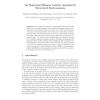Free Online Productivity Tools
i2Speak
i2Symbol
i2OCR
iTex2Img
iWeb2Print
iWeb2Shot
i2Type
iPdf2Split
iPdf2Merge
i2Bopomofo
i2Arabic
i2Style
i2Image
i2PDF
iLatex2Rtf
Sci2ools
ISVC
2010
Springer
2010
Springer
On Supervised Human Activity Analysis for Structured Environments
We consider the problem of developing an automated visual solution for detecting human activities within industrial environments. This has been performed using an overhead view. This view was chosen over more conventional oblique views as it does not suffer from occlusion, but still retains powerful cues about the activity of individuals. A simple blob tracker has been used to track the most significant moving parts i.e. human beings. The output of the tracking stage was manually labelled into 4 distinct categories: walking; carrying; handling and standing still which are taken together from the basic building blocks of a higher work flow description. These were used to train a decision tree using one subset of the data. A separate training set is used to learn the patterns in the activity sequences by Hidden Markov Models (HMM). On independent testing, the HMM models are applied to analyse and modify the sequence of activities predicted by the decision tree.
| Added | 28 Jan 2011 |
| Updated | 28 Jan 2011 |
| Type | Journal |
| Year | 2010 |
| Where | ISVC |
| Authors | Banafshe Arbab-Zavar, Imed Bouchrika, John N. Carter, Mark S. Nixon |
Comments (0)

